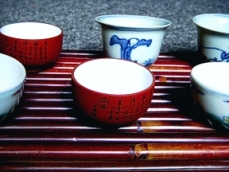 I love Taiwan teas, especially the fragrant green oolongs (or pouchongs) and the relatively new rich black teas. So when TaiwanTeaCrafts.com — a tea exporter that, I am sorry to say, I had never before heard of — offered to send samples of some of their rather excellent teas, I wasn’t about to say no!
I love Taiwan teas, especially the fragrant green oolongs (or pouchongs) and the relatively new rich black teas. So when TaiwanTeaCrafts.com — a tea exporter that, I am sorry to say, I had never before heard of — offered to send samples of some of their rather excellent teas, I wasn’t about to say no!
Some folks enjoy darker, more roast-y oolongs, while others adore their aged oolongs, and you can find several varieties of each at TTC. Me, I like my oolongs as close to green as possible, so that is what they sent to me.
Because they are so green, the teas have to be really fresh to show off their best qualities. As I opened the package of each sample from TTC I took a deep sniff … and let me tell you, these teas were so fresh they could have jumped up and kissed me on the cheek.
To enjoy any tea — but particularly oolongs — it’s important to engage the nose as well as the palate, and to inhale the fragrance at least at these five specific points:
- When you first open the airtight package to enjoy the aroma of the dry leaves;
- At the moment when the leaves first meet hot water for the “rinse” that opens up the leaves;
- Just as you lift the lid of the steeping vessel (teapot, gaiwan) when the tea is ready to pour or sip;
- In the cup as you sip, until you become one with the tea;
- And finally as a fragrant residue on cup, teapot, aroma cup, or the back of a spoon after the tea has been poured from it.
 The first tea I sampled was the Baguashan Jade Oolong (Ciu Yu), lot #150. This was everything I love in oolongs: an enchanting, enveloping floral aroma echoed in the cup, lasting through six infusions, and the leaves with a beautiful rolled appearance with just enough stem attached. Curiously, the slightly pricier organic Jade Oolong (lot #131) was a far paler version … at least to my taste. If you have to choose one, go for the #150.
The first tea I sampled was the Baguashan Jade Oolong (Ciu Yu), lot #150. This was everything I love in oolongs: an enchanting, enveloping floral aroma echoed in the cup, lasting through six infusions, and the leaves with a beautiful rolled appearance with just enough stem attached. Curiously, the slightly pricier organic Jade Oolong (lot #131) was a far paler version … at least to my taste. If you have to choose one, go for the #150.
Now let me explain what I mean by “floral” versus “flowery” teas. A floral tea exudes the sweet, intense perfume of flowers from the first moment your nose, and then your palate, meet them, and continue to do so. The best floral teas permeate the room/s where you’re preparing and sipping them. This jade oolong #150 did exactly that and then some with a beautiful melange of spring fragrances: lilacs, carnations, apple blossoms all rolled into one.
Just exquisite.
And flowery teas? Well, that will be in my next posting!
Follow TeaGuide on Twitter @TeaGuide1
Friend TeaGuide on Facebook
Contact us about reviewing your tea or tea-related product.
All content Copyright 2013 JP Badarau; all rights reserved.
# # # #

